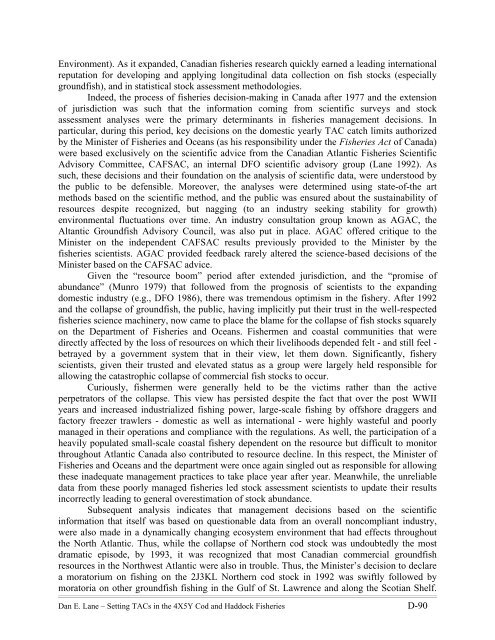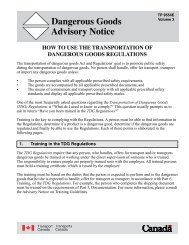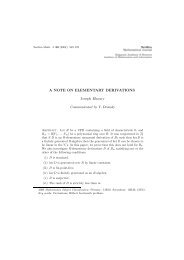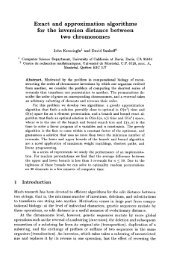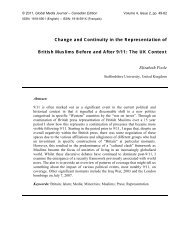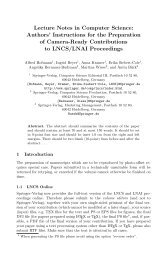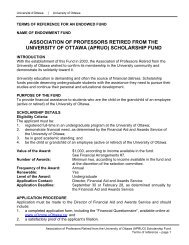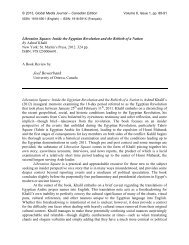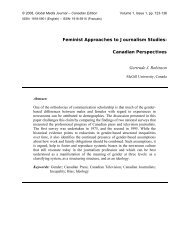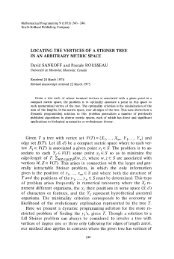PRACTICING PRECAUTION and ADAPTIVE MANAGEMENT ...
PRACTICING PRECAUTION and ADAPTIVE MANAGEMENT ...
PRACTICING PRECAUTION and ADAPTIVE MANAGEMENT ...
- No tags were found...
You also want an ePaper? Increase the reach of your titles
YUMPU automatically turns print PDFs into web optimized ePapers that Google loves.
Environment). As it exp<strong>and</strong>ed, Canadian fisheries research quickly earned a leading internationalreputation for developing <strong>and</strong> applying longitudinal data collection on fish stocks (especiallygroundfish), <strong>and</strong> in statistical stock assessment methodologies.Indeed, the process of fisheries decision-making in Canada after 1977 <strong>and</strong> the extensionof jurisdiction was such that the information coming from scientific surveys <strong>and</strong> stockassessment analyses were the primary determinants in fisheries management decisions. Inparticular, during this period, key decisions on the domestic yearly TAC catch limits authorizedby the Minister of Fisheries <strong>and</strong> Oceans (as his responsibility under the Fisheries Act of Canada)were based exclusively on the scientific advice from the Canadian Atlantic Fisheries ScientificAdvisory Committee, CAFSAC, an internal DFO scientific advisory group (Lane 1992). Assuch, these decisions <strong>and</strong> their foundation on the analysis of scientific data, were understood bythe public to be defensible. Moreover, the analyses were determined using state-of-the artmethods based on the scientific method, <strong>and</strong> the public was ensured about the sustainability ofresources despite recognized, but nagging (to an industry seeking stability for growth)environmental fluctuations over time. An industry consultation group known as AGAC, theAltantic Groundfish Advisory Council, was also put in place. AGAC offered critique to theMinister on the independent CAFSAC results previously provided to the Minister by thefisheries scientists. AGAC provided feedback rarely altered the science-based decisions of theMinister based on the CAFSAC advice.Given the “resource boom” period after extended jurisdiction, <strong>and</strong> the “promise ofabundance” (Munro 1979) that followed from the prognosis of scientists to the exp<strong>and</strong>ingdomestic industry (e.g., DFO 1986), there was tremendous optimism in the fishery. After 1992<strong>and</strong> the collapse of groundfish, the public, having implicitly put their trust in the well-respectedfisheries science machinery, now came to place the blame for the collapse of fish stocks squarelyon the Department of Fisheries <strong>and</strong> Oceans. Fishermen <strong>and</strong> coastal communities that weredirectly affected by the loss of resources on which their livelihoods depended felt - <strong>and</strong> still feel -betrayed by a government system that in their view, let them down. Significantly, fisheryscientists, given their trusted <strong>and</strong> elevated status as a group were largely held responsible forallowing the catastrophic collapse of commercial fish stocks to occur.Curiously, fishermen were generally held to be the victims rather than the activeperpetrators of the collapse. This view has persisted despite the fact that over the post WWIIyears <strong>and</strong> increased industrialized fishing power, large-scale fishing by offshore draggers <strong>and</strong>factory freezer trawlers - domestic as well as international - were highly wasteful <strong>and</strong> poorlymanaged in their operations <strong>and</strong> compliance with the regulations. As well, the participation of aheavily populated small-scale coastal fishery dependent on the resource but difficult to monitorthroughout Atlantic Canada also contributed to resource decline. In this respect, the Minister ofFisheries <strong>and</strong> Oceans <strong>and</strong> the department were once again singled out as responsible for allowingthese inadequate management practices to take place year after year. Meanwhile, the unreliabledata from these poorly managed fisheries led stock assessment scientists to update their resultsincorrectly leading to general overestimation of stock abundance.Subsequent analysis indicates that management decisions based on the scientificinformation that itself was based on questionable data from an overall noncompliant industry,were also made in a dynamically changing ecosystem environment that had effects throughoutthe North Atlantic. Thus, while the collapse of Northern cod stock was undoubtedly the mostdramatic episode, by 1993, it was recognized that most Canadian commercial groundfishresources in the Northwest Atlantic were also in trouble. Thus, the Minister’s decision to declarea moratorium on fishing on the 2J3KL Northern cod stock in 1992 was swiftly followed bymoratoria on other groundfish fishing in the Gulf of St. Lawrence <strong>and</strong> along the Scotian Shelf.Dan E. Lane – Setting TACs in the 4X5Y Cod <strong>and</strong> Haddock Fisheries D-90


